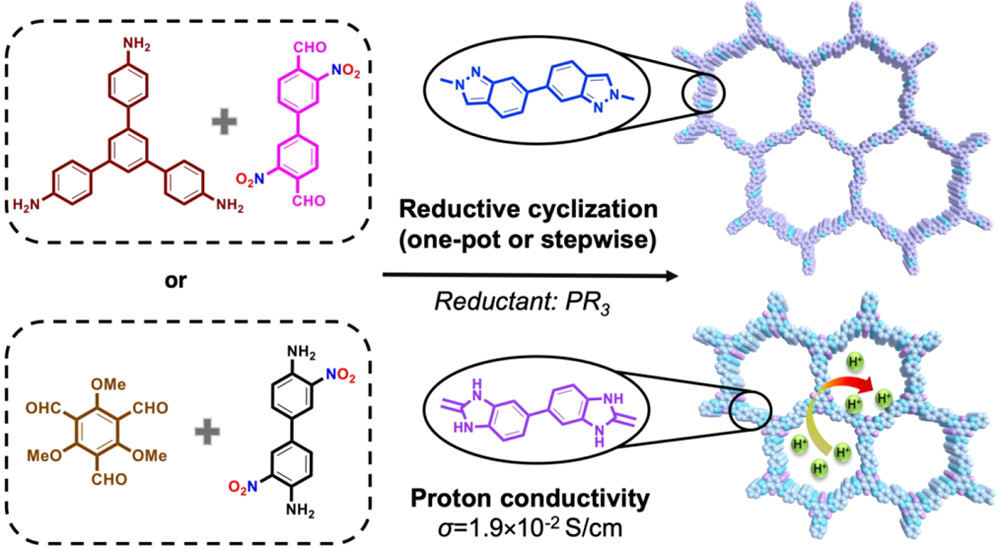By Alison Hatt

Researchers at the Molecular Foundry have developed a new synthetic approach for improving the strength and functionality of a porous, two-dimensional polymer material. The technique enabled the team to customize a material for use in hydrogen fuel cells and other advanced applications.
Covalent organic frameworks (COFs) are polymeric materials made from interconnected molecules in crystalline framework structures, creating precise arrays of nano-sized pores in two- or three-dimensions. Due to their controllable porous structures, COFs are promising for applications involving adsorption and filtration, such as sucking up atmospheric carbon, removing contaminants from water, or corralling hydrogen atoms in a fuel cell.
However, COFs made using existing techniques aren’t robust enough for those applications, which inspired a team of Molecular Foundry researchers to develop a new approach. The results of their work were published in the Journal of the American Chemical Society earlier this year.
“The crystalline structure of COFs is made possible by covalent bonds within polymers that repeatedly break and reform to allow the molecular precursors to settle into an ordered arrangement, but that means the bonds in the final product still break easily,” explained Yi Liu, a staff scientist in the Organic Facility who co-led the study. “We needed the reversible bonds to make the COFs, but also wanted a way to lock the bonds once the framework is formed, to make the COF stronger.”
Synthesizing structured crosslinked polymers has long been a challenge, with limited synthetic approaches available. The Foundry team’s new approach employed a two-step process, where they first synthesized the COF using a standard approach and then cemented the bonds in a second step. The team built the COF using easily reversible imine bonds and then employed a Cadogan reaction to transform those imine bonds into an aromatic framework structure, introducing indazole linkages, making the bonds more stable and essentially non-reversible. The principle of the Cadogan reaction is reductive cyclization, which distinguishes the team’s approach from other post-synthetic modification methods for COFs, which are usually oxidative. The team also discovered that it is not necessary to involve multiple steps for the Cadogan COF synthesis, finding that a one-pot process works better for certain monomers.
In addition to strengthening the COF, the researchers realized that their approach also let them add functional chemical units within the COF’s pores. Conventional approaches to functionalizing COFs require impregnating the COF with external components, such as adding phosphoric acid to aid proton transfer within the pores, creating a kind of composite material. But with the Foundry team’s new method, they could add intrinsic functional groups when they transformed the imine bonds.
“We were able to not just reinforce the bonds but also turn them into functional groups that regulate the interaction with whatever you put in the pores,” said Liu. “It’s like a one stone, two birds scenario. When we developed our approach, it was not designed for proton transfer, but as we discussed with our Foundry colleagues, we realized we could expand the chemistry for that purpose.”
Interested in Becoming a Foundry User?
Join our collaborative, multidisciplinary environment.
Learn more >
To demonstrate the concept, the team expanded their design from the original indazole-linked COF to a system linked by benzimidazole (BIY), thus incorporating the excellent proton transfer properties of BIY into their final product. The team confirmed the success of their approach by measuring the resulting COF’s intrinsic proton conductivity, which out-performed many COFs impregnated with extrinsic proton conductors.
The innovation in the project was based on the development of synthesis techniques and enabled by the Foundry’s suite of characterization tools, including porosity measurement (BET), crystallinity analysis (PXRD), composition analysis (XPS), and proton conductivity measurement, among others.
“It’s a typical Foundry story,” said Liu. “Somebody has a great idea and then the Foundry has the right environment to nurture it.”

